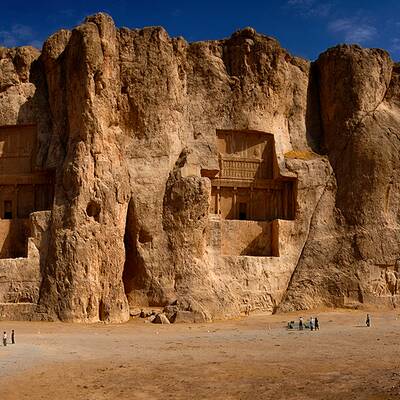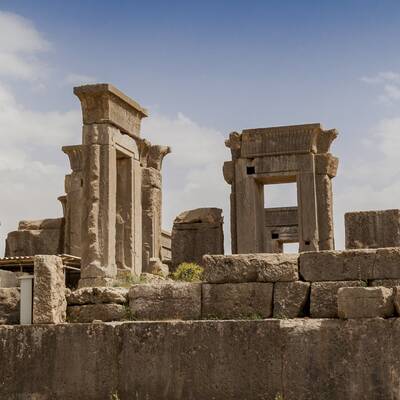Although Naqsh-e Rajab is not as famous as Pasargad and Persepolis, its values are not definitely less than other historical monuments of Fars province.
The petroglyph of Naqsh-e Rajab is the memorial of the early Sassanid kings who were, unlike the Parthian kings, eager to record their history in form of petroglyphs so that they left a museum of carving on the stone in Naqsh-e Rajab and Naqsh-e Rostam.
Naqsh-e Rajab is located three kilometers north of Persepolis, although most of the visitors who come to Achaemenid palace, don’t know Naqsh-e Rajab.
This inscription is placed inside a mountain crack that was located on the path of Persepolis to Estakhr city in time of Sassanid empire. Estakhr was one of the largest ancient cities of Iran and the hometown of Ardeshir and Shapur.
The petroglyph is 13 kilometers far from Marvdasht and 56 kilometers from Shiraz. There are four stone reliefs and two inscriptions in the area of Naqsh-e Rajab.
It seems Rajab is not the name of any ancient character, it is probably the name of a person who had a coffeehouse nearby. You can see the first relief immediately after reaching the mountain that is related to the ceremony of Ardeshir Papakan’s coronation. He was the founder of Sassanid dynasty who declares his kingship through this carved stone.
Ardeshir is seen in this relief raising his left hand respectfully while taking the kingship ring or Deyhim from the senior mobster. The senior mobster has an object in his left hand some calls it the holy plant and some others consider it to be the kingship stick. There is a person standing near Ardeshir who holds a flapper over the head of king. One of the elders of the court is also present.
Two children have also been depicted one of them is probably the prince and the other can be the symbol of Ahura Mazda. Two court ladies are also present in the scene and a person pointing the relief to introduce it to others, who stand at the end.
The second relief includes the scene of Shapur I, Ardeshir Papakan’ son, coronation. The horseback Shapur is receiving the crown or kingship’s ring from horseback senior mobster.
In the northern part of the area of Naqsh-e Rajab, another relief is seen depicting Shapur next to nine figures of Sassanid elders. One of them is Hormoz I that is distinguishable through the sign of substitution on his hat. A Pahlavi inscription has been carved on the body of Shapur’s horse. This petroglyph is approximately one meter and a half upper than the ground level.
Another relief shows Kartir, the Zoroastrian magus, that is accordingly called Kartir inscription. He was an influential and powerful magus who held his position continuously during the reign of six Sassanid kings, from Ardeshir Papakan to Nerseh.
The existing descriptions narrate his prejudice to Zoroastrian religion. He has been depicted in this relief as a man without beard with a hat on his head. There is an inscription in this relief introducing Kartir in Pahlavi language. This confirms his power in Sassanid regime because it was only kings who could have an inscription or relief in such a significant place.
All days of a week, except for the official holidays, you can visit Naqsh-e Rajab from 8:00 a.m. to 5:00 p.m.





